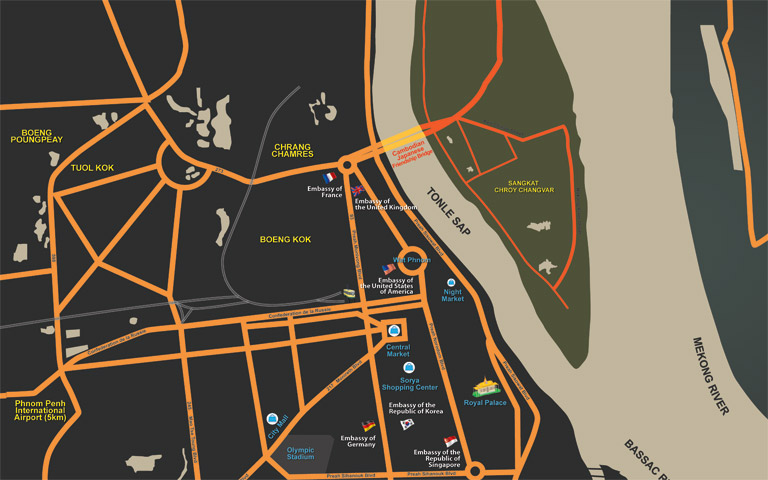Areas Attractions > Phnom Penh History
Phnom Penh
Located on the banks of the Mekong River, Phnom Penh has been the national capital since the French colonized Cambodia, and has grown to become the nation's center of economic and industrial activities, as well as the center of security, politics, economics and diplomacy of Cambodia.
Once known as the “Pearl of Asia”, it was considered one of the loveliest French-built cities in Indochina in the 1920s. Today Phnom Penh is a charming, relaxing and harmonious city. Phnom Penh, along with Siem Reap and Sihanouk Ville, are significant global and domestic tourist destinations for Cambodia. Founded in 1434, the city is noted for its beautiful and historical architecture and attractions. There is a number of surviving French colonial buildings scattered along the grand boulevards.
History
Long ago in 1372 A.D., there was a wealthy elderly woman named Penh living near the banks of the four river fronts. Her house was built on a plateau east of a hill. One day, heavy rains flooded the area. Daun Penh (Grandma Penh) went down to the dock and saw a koki tree floating towards the river bank. The strong fronting tides kept the koki tree floating nearby that particular river bank.
Immediately, Daun Penh called for her neighbors to help get the tree out of the river. They tied a rope to the tree and gradually pulled it out of the water. While Daun Penh was wiping the mud off of the tree, she saw four Buddha bronze statues and a stone statue of Divinity in the hole of the tree trunk. The statue of Divinity was standing and held a bat in one hand and a conch shell in the other.
Daun Penh and her neighbors were very happy to see those sacred objects and paraded them to Daun Penh's house. She arranged to have a small hut built to temporarily house the statues.
Later, Daun Penh called on her neighbors again for help to pile up more dirt on the hill west of her house. The koki tree was then cut and fashioned to become pillars of the temple which would be built on that hill.
In 1372 A.D., Daun Penh and her neighbors all agreed to build a temple with a thatch roof on the hill. The four Buddha statues were placed in the temple, while the statue of Divinity was kept in a shrine at the east base of the mountain, for she thought that the statue was from Laos because of its appearance and name "Neakta Preah Chao" which is what is has been called ever since.
After the temple was built, Daun Penh invited monks to stay at the base of that hill. Since then, it was been called Wat Phnom Daun Penh, also presently known as Wat Phnom.
Phnom Penh City was first built in the 15th century during King Preah Srey Soryopor's (Ponhea Yat) time, when he abandoned Angkor Palace and built a new one at Tuol Basan in Srey Sar Chhor province, which is now called Srey Santhor district, Kampong Cham province. The king stayed there for only one year due to flooding every rainy season. He moved and built a new city along the bank of Tonle Chaktomuk (Four Faces River) in 1934, which is now Phnom Penh City today.
There were two phases in the construction of the Royal Palace in Phnom Penh City:
Phase One: During King Preah Ponhea Yat's reign in the 15th century.
Phase Two: During King Norodom’s reign in the 19th century.
There were two phases of construction because after Phase One (1434 – 1497), the king's palace was moved back to Angkor. After it was built in Angkor, it was then moved to Pursat, then Boaribo, next to Longvek, and then Oudong. After Oudong, the Palace was built again in Phnom Penh City in 1865 and has stayed there ever since.
Source: http://www.phnompenh.gov.kh
 Tel: +855 23 987 888 / 088 26 36 318
Tel: +855 23 987 888 / 088 26 36 318







